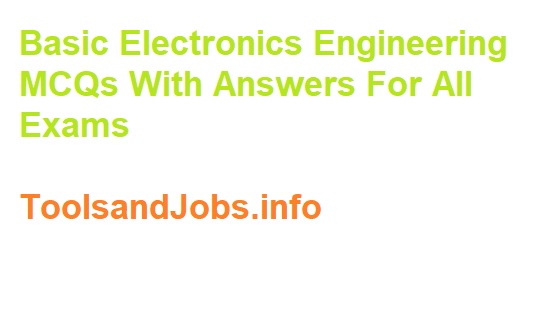This is part 4 of the MCQs of Basic Electronics Engineering. This contains mcqs on topic Diode Circuits. Contains most important and most asked questions.
Click to read part 1
Click to read part 2
Click to read part 3
Before solving this questions I suggest you must read this basic electronics
1. The LED emits light when_______biased.
a. reverse
b. unbiased
c. forward
d. none of these
Ans: d
2. The LED works on the principle of
a. fluroscence
b. hall effect
c. electroluminescene
d. none of these
Ans: c
3. GaAsP LEDs are used to produce __________ color light.
a. red
b. green
c. orange
d. white
Ans: a
4. The ______controls the brightness of LED.
a. Forward voltage
b. Forward current
c. Materal used
d. none of these
Ans: b
5. A photodiode operates in __ condition.
a. reverse biased
b. forward biased
c. parallel with load
d. none of these
Ans: a
6. _______ is always operated in reverse biased condition.
a. LED
b. Photodiode
c. Transistor
d. Rectifier
Ans: b
7. The current in photodiode increases as the light intensity.
a. remains same
b. decreases
c. increases
d. none of these
Ans: c
8. The dark current in photodiode is due to ________ charge carriers.
a. majority
b. minority
c. both the
d. none of these
Ans: b
9. The photodiode is _______ device.
a. photoemitter
b. photorejector
c. photodetector
d. none of these
Ans: d
10. The luminous efficiency of LEDs is _____.
a. high
b. low
c. zero
d. none of these
Ans: b
11. The luminous efficiency of LEDs is measured in ______ .
a. lumens/watt
b. watts/lumen
c. lumens/degree C
d. lumens/ampere
Ans: a
12. _______ is used in optocouplers.
a. Zener
b. LED
c. SCR
d. Transformer
Ans: b
13. The photodiode current under no light is called _______ current.
a. forward
b. maximum
c. dark
d. none of these
Ans: c
14. The dark current of photodiode is always
a. large
b. very small
c. zero
d. infinite
Ans: b
15. Photo current is directly proportional to __
a. forward current
b. reverse current
c. intensity of light
d. none of these
Ans: c
16. The intensity of light is measured in ______ .
a. Lm/A
b. Lm/W
c. Lm/w2
d. Lm/m2
Ans: d
17. The photodiode characteristics lies in _____ quadrant.
a. first
b. second
c. third
d. fourth
Ans: c
18. The current is photodiode is due to ______ carriers.
a. majority
b. minority
c. both
d. none of these
Ans: b
19. The LED is _______ device.
a. photoemitter
b. photorejector
c. photodetector
d. none of these
Ans: a
20. A photodiode converts _____ .
a. light energy into chemical energy
b. chemical energy into electrical energy
c. light energy into electrical energy
d. electrical energy into light energy
Ans: c
21. A LED converts ___ .
a. light energy into chemical energy
b. chemical energy into electrical energy
c. light energy into electrical energy
d. electrical energy into light energy
Ans: d


